
Digimon Story: Time Stranger Review
I wasn’t sure what to think of Digimon Story: Time Stranger when it was first revealed back in February. The last several Digimon games I’ve played didn’t quite land for me. Digimon Story: Cyber Sleuth and Hacker’s Memory were both created for the PS Vita in mind, so both entries’ weaker elements could be attributed to being built for weaker hardware from the get-go. Meanwhile, Digimon Survive, the 2022 adventure game with strategy RPG battles, was a title that I strongly disliked for its lackluster execution on an intriguing premise.
While I try my best to mentally separate newer titles from past experiences in the same series or IP, the consistent letdown of the past several Digimon games left me apathetic at first for Time Stranger. It wasn’t until my hands-on time with it at Summer Game Fest and PAX West that I began to truly anticipate it. There was a certain charming aspect to it that was reminiscent of RPGs from Japanese developers in the PS2 era.
The past several years in the video game industry have brought about a collective yearning to either revisit, revive, and/or reimagine the spirit of games we played when we were all much younger. This has come in the form of remasters, remakes, and brand-new titles that pay homage to the titles that inspired their creators. These older titles captivated their would-be fans, even though most of them possessed some elements that could be considered unrefined or cumbersome.
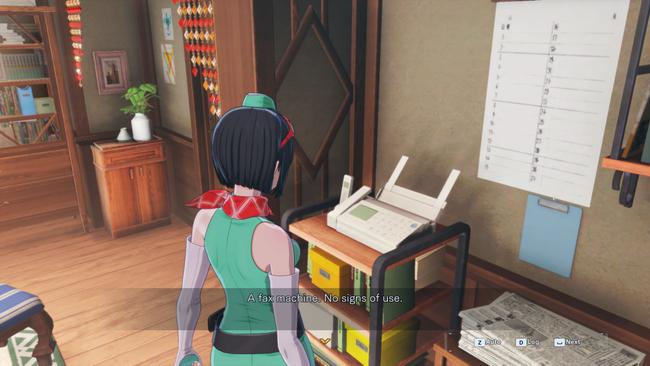
I mention all of this because I think Time Stranger is an excellent game that reminds me a lot about the highs and lows that PS2-era JRPGs brought along with them. It contains a solid story, a likable ensemble of characters, and fulfilling progression mechanics – but it also bears a lot of clunky user experience issues, such as too much menuing when training Digimon, an awkward fast traveling system, and uneven narrative presentation values.
Even if you’re not a fan of Digimon or unfamiliar with the Digimon series at all, I think Time Stranger is a great standalone RPG experience. If you have any curiosity or a desire to see all the different shapes and sizes of what playable digital monsters this game has, there’s a real possibility you might become addicted to it.
Time Stranger puts the player into the shoes of a secret agent who serves the enigmatic ADAMAS organization that investigates anomalies around the world; people can choose between Dan or Kanan, the male and female protagonists respectively. People can freely swap over to the other protagonist and choose a different name after they begin the game at any time from the options menu. For this review, I’ll refer to my main character as Kanan since I chose her and just stuck with her default name.
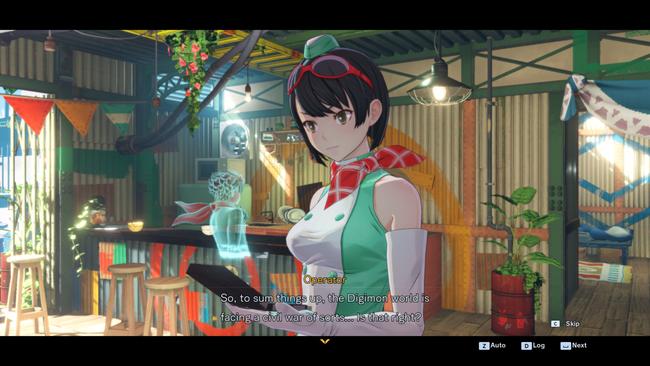
The introduction of Time Stranger is deliberately surreal. After a series of unfortunate events that trigger the Shinjuku Inferno catastrophe, players find themselves stuck eight years in the past. It starts with a simple goal – find a way back into the present, and investigate any clues that could help prevent the Shinjuku Inferno along the way.
This opening section unfolds slowly. Time Stranger takes its time to introduce one of its major characters, Inori Misono, and all the prominent side characters involved in the Human World side of the game. Honestly, I felt this was a bit too slow because all the gameplay battle portions here were confined to revisiting the same sewer dungeon again and again for a few hours. I can understand and appreciate the decision to build up its story early on, though I think this section absolutely needed another explorable dungeon to keep it fresh.
Eventually, Inori meets Time Stranger’s other major character – Aegiomon. It often feels like Inori and Aegiomon are the game’s real main characters early on because the chosen protagonist is silent most of the time.
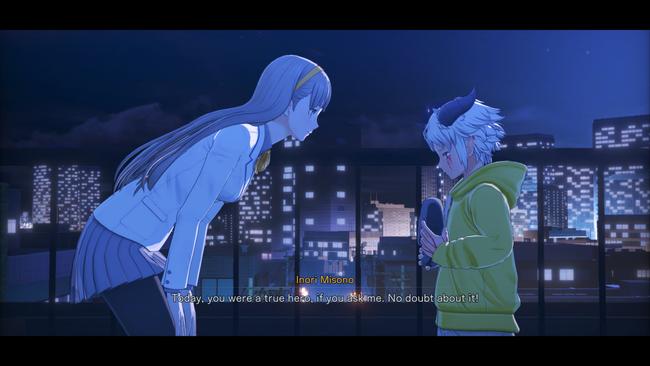
The unchosen other protagonist (Dan in my case) serves as the operator, and their communication with your selected character is mostly voiced. All the selectable responses and story cutscenes didn’t have Kanan voiced, so she often felt disconnected from the narrative since many other characters do get to have some voiced lines; meanwhile, the majority of Kanan’s voiced clips were confined to a few battle lines. The disjointedness is further exacerbated because Kanan actually moves her mouth at times when responding to dialogue, but it’s all completely silent.
It took roughly four to five hours for Time Stranger to start hitting its stride for me, which is when Kanan, Inori, and Aegiomon travel to the Digital World: Iliad for the first time. As a side note, Iliad is an entirely different Digital World than what’s depicted in the early anime seasons of Digimon. I was a big fan of the first three seasons, so I had to wrap my head around that Iliad in Time Stranger is a Digital World hosted on a different server.
When I walked around Central Town in this game for the first time, this was the moment that I started to fall in love with it. The attention to detail in making the Digital World feel alive in Time Stranger is astounding. There are so many Digimon from top to bottom throughout this space, including a bar filled to the brim with Digimon simply hanging out.
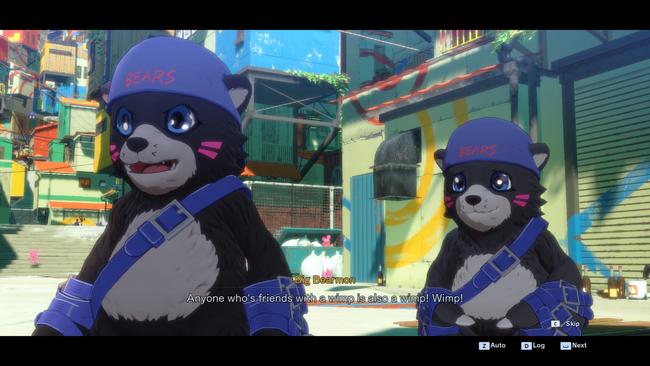
This is also true for all the other areas that players will be traveling to in Iliad. They each contain environmentally themed Digimon of all shapes and sizes gathering together and sometimes interacting with each other in fun ways. The Gear Forest has lots of insect Digimon like FunBeemon, Kabuterimon, and Kuwagamon. Meanwhile, the Abyss Area has many water and beach-oriented Digimon, including Seadramon, ShellNumemon, and a MarineAngemon performing in front of a small group of fans.
If there’s one singular triumphant aspect of Time Stranger, it’s that this is the Digimon game that finally shows that it received a proper amount of time, care, resources, and energy to fully depict the liveliness of the Digital World in a game. While Cyber Sleuth and Hacker’s Memory were still bound by their PS Vita roots in their Complete Edition releases on other platforms, Time Stranger is able to flex that it was built and designed from the ground up with current-generation hardware in mind.
Time Stranger’s journey to release kept emphasizing that this Digimon Story entry would have the largest roster of Digimon in the series, with over 450 Digimon. This huge number led me to believe that they would be importing and touching up models from the previous Digimon Story games until they revealed in a development video that every single Digimon model was created from the ground up; they even did several model comparisons between Cyber Sleuth and Time Stranger. It was clear as day that the Time Stranger models were completely new and far more detailed.
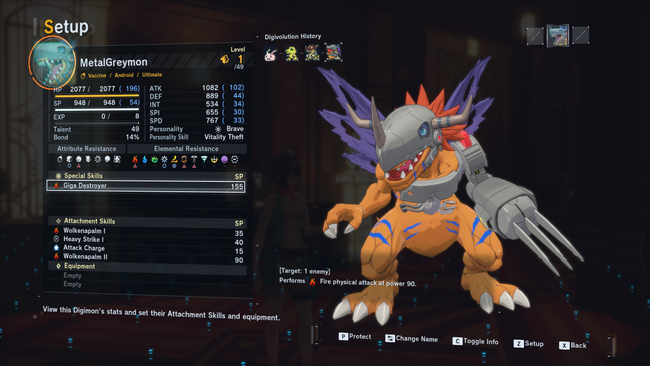
I went out of my way to fill out the entire Field Guide, the Pokedex equivalent, in Time Stranger, just to see every single Digimon. They look incredible, and it is such an amazing achievement to fully model and animate that amount of Digimon while all giving them a bit of personality in that process.
Before proceeding, I should probably briefly explain how Digimon evolutions work. As Digimon become more powerful, they proceed through several distinct stages starting from In-Training, In-Training II, Rookie, Champion, Ultimate, and finally Mega. Digimon possess a non-linear evolution tree, so they often have multiple different Digimon they can evolve into, which are referred to as Digivolutions. They can also De-Digivolve, which reverts them back into earlier stages on the evolution tree. So for instance, it’s entirely possible to De-Digivolve a Champion back into a different Rookie it evolved from, and that Rookie can go into an entirely different route chain of Digivolutions.
Unlike the last Digimon Story installments, Digivolutions can be directly accessed from the menu now; there’s no need to go to a distinct DigiLab location like in the previous titles to access them. Plus, the Digimon inventory box, previously referred to as the DigiBank, is with you at all times now, too. It has a max cap of 999, and all the Digimon stored in it will receive some of the experience points gained from battle. Time Stranger is a much smoother game to navigate because of tweaks and improvements like these.
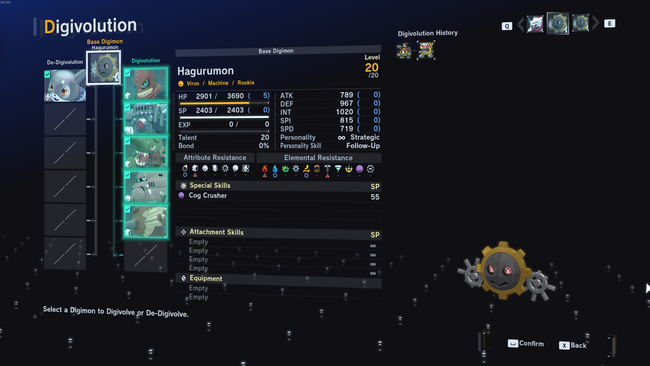
Digivolving in this game involves Digimon meeting certain stat requirements, which are all clearly laid out when hovering over each of their Digivolutions. Time Stranger also introduces a new Agent Rank requirement into the mix, which acts as a gate to manage players’ power progression. There were certain exploitable methods to accelerate to higher evolution stages in the previous Digimon Story games, much faster than what was intended. Time Stranger tries to keep that in control, since Agent Rank can only be raised by spending Anomaly Points earned through completing main missions and side quests. Anomaly Points are spent on Kanan’s gun device to open up new X-Art abilities, raising Digimons’ stats of a certain personality type, reducing the stat requirements to Digivolve, and so on.
I appreciated this mechanic because it allows players to go through a more natural power ramp as the plot progresses. It felt extremely gratifying when I finally met the Agent Rank thresholds that unlocked the Champion, Ultimate, and Mega stages; almost all of the Digimon in my inventory box lit up, indicating that they were all ready to Digivolve. Time Stranger does a decent job pacing out these big thresholds too and provides a great, compelling incentive to do all of its side quests to get to these higher Agent Ranks quicker.
The side quests themselves are pretty simplistic in nature, though several of them do follow a persistent story chain that continues an earlier plotline. Digimon Story titles usually have their fair share of bizarre, sometimes borderline degenerate, quests, as Digimon often end up in scenarios influenced by human activity. This usually leads to some comedic interactions in those titles, and Time Stranger continues that tradition. I think some of them, along with a few main story objectives, involve a bit too much backtracking, which almost feels like an antiquated issue that most modern games have largely overcome — PS2-era JRPGs certainly did have their fair share of backtracking issues though.
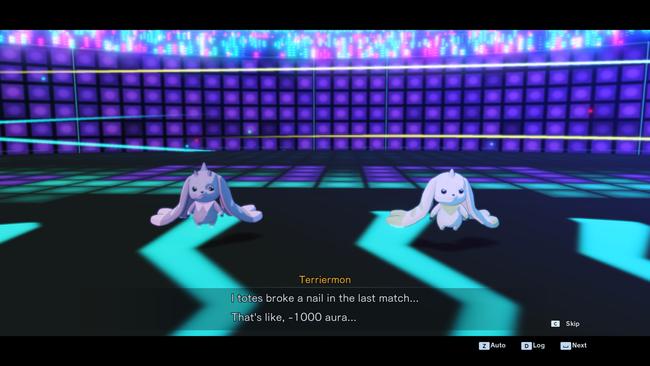
Time Stranger’s frequency of side quests caught me off guard, though. The game purposefully dripfeeds a few at a time throughout the majority of Kanan’s journey, so they never take too much time away from the main quest. Then, as a classic genre trope, an absolute flood of them opened up right before the main story’s finale.
It’s worth mentioning that most of the DLC costumes in the Deluxe and Ultimate Editions contain their own exclusive side quests. These are very fast, simple side quests that involve either a NPC or a premise to put on the costume and maybe fight a battle to finish it; they do not reward Anomaly Points, so these paid DLC sets do not provide an avenue to accelerate progress.
Speaking of combat, Time Stranger’s battle system is a bit of a mixed bag for me. I think its foundation is solid, but I think it only really shines in boss battles. It’s a straightforward turn-based battle system with an action order timeline. Up to six Digimon can be in a player’s main party, but only three of them can be out on the field at any given time. There are an additional three slots reserved for guest party members; Aegiomon counts as a guest that can be controlled with his own HP and SP bar to manage. Other guests besides Aegiomon will act on their own and are immortal, so they can soak up hits from time to time.
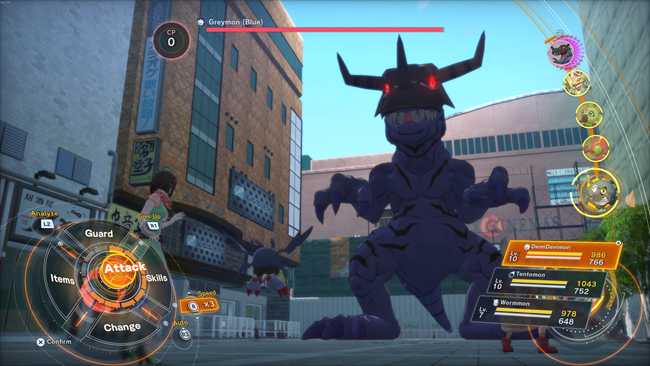
Bringing a reserve party member to replace an active one does not consume a turn and can be done multiple times as long as that party member doesn’t commit to an action. Using a consumable item also doesn’t use up a turn, but only one item can be used per turn. These mechanics influence the design of Time Stranger’s boss battles, because they’re often aggressive about hitting multiple party members with stat debuffs, status ailments, and continually boosting their own stats.
Learning how to manage multiple weaknesses to amplify a Digimon’s damage multiplier is the heart of Time Stranger’s combat. The vast majority of Digimon are categorized as Vaccine, Data, or Virus types that have their own rock, paper, scissors chemistry with each other. Additionally, many Digimon have elemental resistances and weaknesses and carry certain Traits. Damage calculations are balanced between each of these three types, element, and trait categories.
For example, a Gotsumon is a Data-type Digimon, so that makes it strong against Vaccine and weak against Virus. Its elemental weaknesses are Grass and Wind, but strong against Water and nullifies Earth; the traits it possesses are Medium and Mineral. If I were to hit it with a normal attack from a Virus-type Digimon, it’d have a x2 multiplier, so it does double the damage. Additional damage multipliers can be stacked on if I had that Virus-type Digimon cast a wind spell; if that Virus-type Digimon had a unique wind attack that did extra damage to Digimon with the Mineral trait, the damage multiplier could go as high as 450%. Inversely, firing off a water ability with a Vaccine-type Digimon would merely chip it.
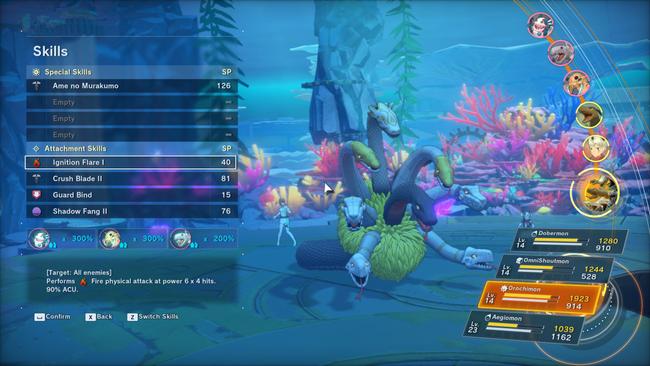
The battle UI does a fantastic job of conveying all these damage multiplier calculations at a glance when hovering over abilities. Hitting weaknesses gradually fills up Kanan’s X-Arts (pronounced as Cross Arts) gauge. What the X-Art does is up to the player; these can take the form of providing buffs to the party, dealing damage to foes, or healing the team when they need it the most. This system works both ways, of course, so it’s not unusual to see a Digimon’s lifebar nearly go to zero after one or two hits because their weaknesses are all in the strike zone for foes.
Boss fights often have their own exclusive mechanics that make this whole dynamic engaging. An early example is a Digimon piloting a device with multiple arms; each of those arms has a different type, so they’re each weak to different types of Digimon. The boss does a super powerful attack after a set number of turns involving all the arms, but it can be weakened and eventually disabled entirely, as more arms fall.
There are more creative boss mechanics that I don’t want to reveal, but I really enjoyed Time Stranger’s boss fights. They often surprised me or caught me off-guard, though sometimes they could be sheer trial and error from the first turn, since I sometimes had a party where most of them were hard-countered by the boss’s type or elemental spells it had. Attacks are categorized between physical and magical attributes, too, and this becomes important when there are shields that completely nullify one of them temporarily.
Bosses will usually enter a “charge up” phase where a secondary bar appears. As it’s charging up to use a devastating attack, another part of the boss becomes targetable, which will decrease that bar when attacked. Depleting it successfully in time will briefly stun the boss, but failing to do so… well, that’s what the guard command is for.
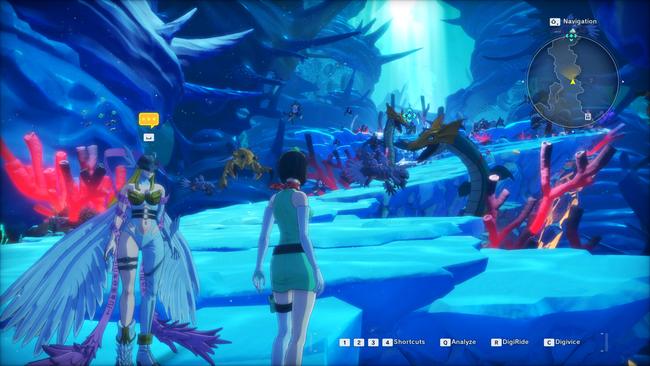
On the other hand, a vast majority of smaller non-boss encounters aren’t that engaging at all. As long as my active party wasn’t completely at a disadvantage, they were almost all successfully resolved via auto-battle. Lots of my battle encounters in Time Stranger were flipping on the x5 battle speed option and letting battles resolve themselves, even on Hard mode. The unlockable Mega and Mega+ difficulties after beating the game are a different story; all the enemies’ stats are tuned to be a threat even for endgame parties at the beginning, so those who want every fight to be challenging will have to wait to unlock those.
While I’m not too fond of normal battles being a bit too simple, I do understand their benefits. Defeating a Digimon raises its convert meter. Filling up its convert meter to 100% will allow people to acquire that Digimon immediately, though holding off to higher values up to 200% will give them a higher level cap and increased stats when that Digimon joins up. One of the more perplexing design decisions is having to stay still for several seconds to fully heal up all of the party’s HP and SP; I prefer it if they just healed to full after every battle, instead of going through this extra step every so often. Once again, I think Time Stranger’s battle system works well in practice for encounters that push players to engage with it thoroughly.
Each Digimon has at least one signature attack that’s exclusive to that Digimon alone, with later Digimon stages in their Ultimate or Mega forms usually having two or three of them. All signature attacks have a unique attack animation with the Digimon saying the name of the attack out loud. Since Time Stranger has an English dub this time around, unlike previous Digimon Story games, there are a ton of different English voices involved with just the Digimon attacks alone, along with their lines playing during their win animation. As I mentioned earlier, the attention to these details throughout Time Stranger oozes a lot of heart that reminded me of older RPGs.
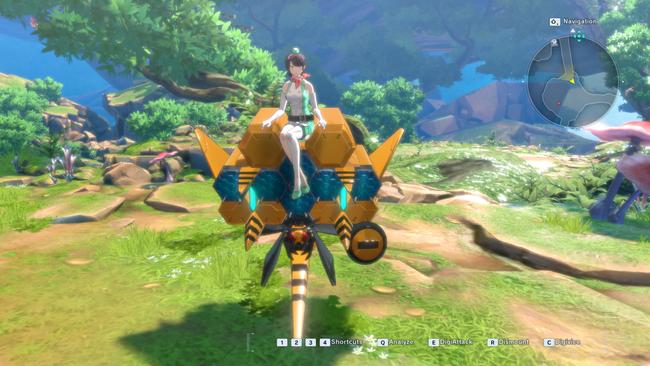
Digimon can equip up to four attachment skills, as well. These skills are obtained by Digimon leveling up and can also be bought through shops. Attachment skills consist of elemental abilities that either scale off of physical or magical damage, recovery skills, and stat buffs/debuffs. They are fully swappable so when a Digimon learns an attachment skill when it reaches a certain level, that can be taken off of them and given to another Digimon.
A large number of Digimon in Time Stranger’s roster are rideable, too. Not all of them are faster than simply running around, amusingly enough; there are a few different positions on which the Digimon can be mounted on a case-by-case basis. Kanan sits on a Digimon’s shoulder or on top of them, while special cases like Beelzemon and Witchmon have her sitting behind them on their respective motorcycle and flying broom vehicles. It’s a bit of a shame that there aren’t any sound effects associated with a mounted Digimon moving around, but I appreciate that this feature was implemented in an enjoyable way.
One of the more intriguing features introduced in Time Stranger are “temporary” DNA Digivolution attacks. In Digimon, there are specific Digimon that can be combined to make an entirely new one; a well-known DNA Digivolution is when ExVeedramon and Stingmon combine to make Paildramon. DNA Digivolution is often a permanent combination unless it's De-Digivolved. Now in Time Stranger, DNA Digivolutions can be used as one-off attacks.
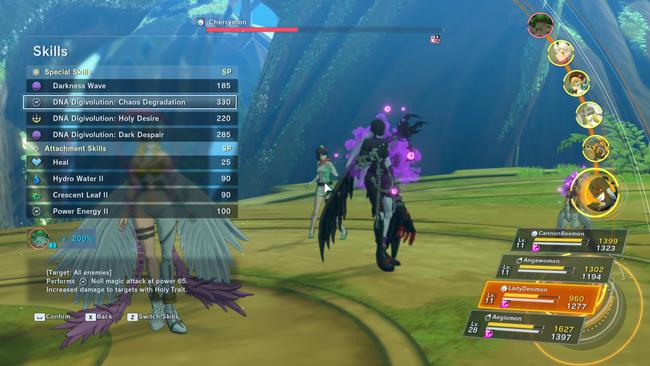
If I have ExVeemon and Stingmon both out in the field, they’ll have new attack options that contain “DNA Digivolution” in them. Choosing these attack options will have both Digimon combine into Paildramon briefly to fire off that attack, and separate once more. Using this ability will consume both Digimons’ turns and the SP needed to execute that attack.
The DigiFarm in Time Stranger allows people to train up multiple Digimon’s specific stats passively. Digimon placed in the DigiFarm still collect experience points normally, as if they were in the Digimon inventory box. The key part of the DigiFarm is that the training set items used for raising a Digimon’s stats are reusable.
For instance, I want to get a Leomon’s ATK stat up to 2200 because that’s what it needs to Digivolve into IceLeomon. I have five training sets that raise ATK moderately, so I give one of them to Leomon, and it will take one real hour for it to finish. Once it’s done, that training set is given back to the player and can be reused. If that hour sounds too long, people can spend in-game money to immediately finish it.
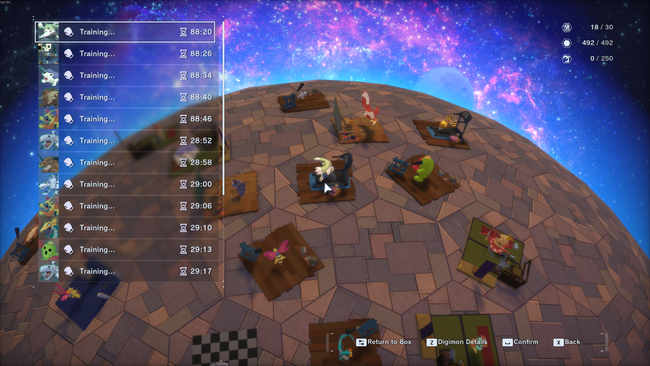
I started to play Time Stranger with a notepad in hand due to the DigiFarm. Before placing any Digimon in it, I started to meticulously catalog which Digimon would be paired with each of my Training Sets to build up their stats to Digivolve. New training sets can be crafted at the Zudomon blacksmith; I eventually started to save much of my in-game money to speed up training on sets that took 90 minutes to complete, since it cost the same as speeding up lower value sets that took only 30 minutes to finish.
Going back and forth between the DigiFarm and Digivolution menus started to get on my nerves when filling out my Field Guide, and I wish there was an option to just pop up a Digimon’s Digivolution menu directly from the DigiFarm interface itself.
Another fun distraction, that adds some trippy visual variety, are Time Stranger’s Outer Dungeons minigame sections. Don’t be fooled when popping open the Outer Dungeons menu for the first time; these aren’t just reserved for experience, money, and material farming DLC. They are discoverable red rifts that lead to a minigame activity that rewards a powered-up Digimon for completing it.
Some of these minigames include racing a Digimon while avoiding obstacles, and surviving continual spawns of Digimon in a small arena by dodging them for a minute and a half. Time Stranger also has a simple collectible card game and every Digimon has their own card, so it's another fun tiny thing to do on the side. These were small, yet enjoyable experiences.
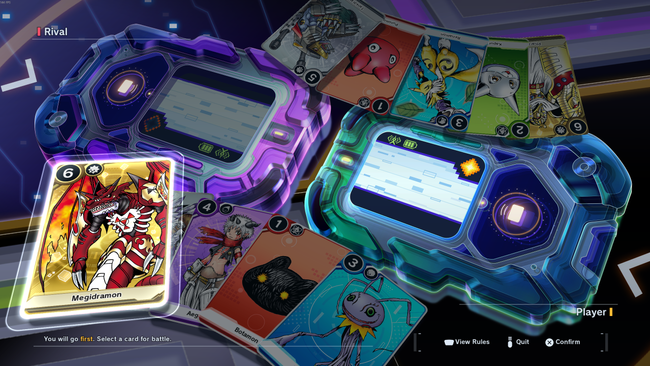
Lastly, I did find the fast travel system in this game clunky in a… PS2-era-y way. There’s no instant fast travel done from a menu that many modern RPGs have adopted. After clearing out an area, a Birdramon NPC will give players a few options of which significant landmark they want to instantly travel to, but only for that specific zone.
Let’s say I wanted to get to the Warrior’s Watering Hole bar in Central Town from the Gear Forest Village. I have to go run over to Birdramon in Gear Forest Village, say that I want to go to the Locomon train in Gear Forest, then talk to Locomon and choose Central Town from the map menu. After I arrive in Central Town, I have to go to Birdramon yet again and finally choose the Warrior’s Watering Hole option to get there; this process becomes more complex as additional narrative elements get introduced into the fray. It is a truly cumbersome system that touches upon a bygone era of how RPGs used to handle this.
My first playthrough of Time Stranger ended up being 60 hours, though roughly 20 hours of that was spent on filling out my Field Guide thoroughly throughout the game. I think a normal playthrough will probably end up more around the 40-45 hour range, if you're not too concerned about filling out every single Digimon's Digivolution tree. It's a fairly lengthy game, but it doesn't overstay its welcome.
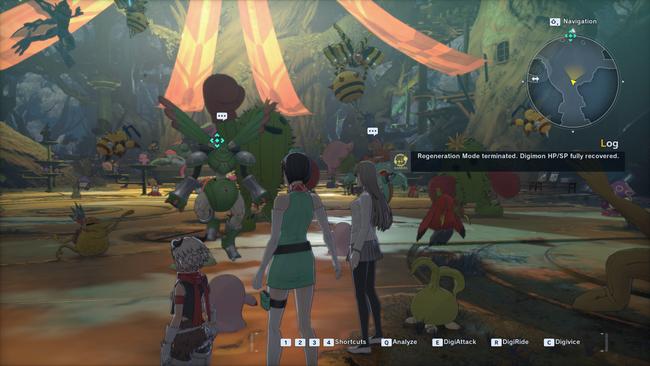
Digimon Story: Time Stranger is an excellent game that carries the spirit of a PS2-era JRPG in its heart. The sheer amount of care put into portraying the Digital World: Iliad and all the Digimon that inhabit it clearly shows the passion that the developers had when developing Time Stranger throughout the years. Its narrative has its fair share of ups and downs, but I think it goes into some wild places and finishes very strong with a finale that will have Digimon fans screaming in joy. There’s certainly a handful of unrefined aspects, such as how its fast travel is handled and the disjointed feeling brought about by its unvoiced protagonist, but it can’t be denied that this is not only one of the best Digimon games ever – it’s just a damn good game on its own.